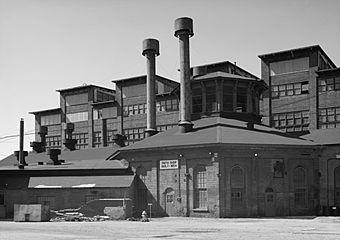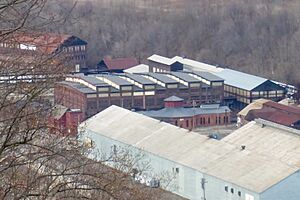Cambria Iron Company facts for kids
|
Cambria Iron Company
|
|

Blacksmith Shop in 1958
|
|
| Location | Johnstown, Pennsylvania |
|---|---|
| Area | 482 acres (195 ha) |
| Architect | Cambria Iron Co., et al. |
| NRHP reference No. | 89001101 |
Quick facts for kids Significant dates |
|
| Added to NRHP | June 22, 1989 |
| Designated NHLD | June 22, 1989 |
The Cambria Iron Company was a very important company in Johnstown, Pennsylvania. It made a lot of iron and steel. The company was open from 1852 to 1916. It was known for using new ideas in making steel. Some of these ideas came from inventors like William Kelly and Henry Bessemer.
The company started in 1852. Within 20 years, it became the biggest steel factory in the United States. In 1898, its name changed to the Cambria Steel Company. Later, in 1916, another company called Midvale Steel and Ordnance Company bought it. Then, in 1923, the Bethlehem Steel Company bought it.
The company's factories stretched for about 12 miles (19 km) along the Conemaugh and Little Conemaugh rivers. They kept working until 1992. Today, these old factory areas are a special place called a National Historic Landmark District. This means they are important parts of history.
Contents
Factory Locations and History
The Cambria Iron Company had five different factory areas. These were in and around Johnstown, Pennsylvania. The oldest factories were called the Lower Works. They were on the east side of the Conemaugh River. This was north of downtown Johnstown.
Other factories included the Gautier Plant. It was northeast of downtown Johnstown. The Franklin Plant and Wheel Plant were further up the Little Conemaugh River. The Rod and Wire Plant was on the west side of the Conemaugh River.
Each of these factory areas shows a different time in the history of making steel. The Lower Works does not have many signs left of its very first buildings. All five of these areas together became a National Historic Landmark District in 1989.
How the Company Grew

The Cambria Iron Company started in 1852. Its main goal was to make iron for building railroads. In 1854, a group of business people from Philadelphia bought the iron works. They were led by Matthew Newkirk. A big fire destroyed the main factory in 1857. But Newkirk convinced the others to rebuild it even bigger.
The company grew very fast. By the 1870s, it was a top steel producer. It also came up with many new ways to make steel. For example, it tried early experiments with the Kelly converter. It also built the first "blooming mill." This machine helped shape large pieces of steel. Cambria was also one of the first to use water power (hydraulics) to move heavy steel blocks.
The company built one of the first large factories to use the Bessemer process. This was a new way to make steel quickly and cheaply. Cambria's new ideas and methods were used by many other steel companies.
Leadership and Challenges
The company was at its best in the 1870s. This was under the leadership of general manager Daniel Johnson Morrell. He helped the factories grow into one of the biggest makers of railroad tracks in the United States. He also helped the U.S. stop relying on other countries for railroad parts. Morrell was also a politician. He served in the U.S. Congress from 1867 to 1871.
Morrell became worried about the South Fork Dam. This dam held back Lake Conemaugh above Johnstown. The Cambria Iron Company's factories were below it. To keep an eye on the dam, Morrell joined the South Fork Fishing and Hunting Club. This club owned the dam. Morrell asked the club leaders to fix the dam. He even had his own engineers check it. He offered to pay for some of the repairs himself. But the club president, Benjamin F. Ruff, said no. Morrell passed away in 1885. His warnings about the dam were not listened to.
On May 31, 1889, the dam broke. This caused the terrible Johnstown Flood. More than 2,200 people died. It was the biggest disaster in U.S. history at that time. The flood also badly damaged the Cambria Iron Company's factories. The company reopened just one week later. But it could not make as much steel as before. Other companies became bigger as Cambria rebuilt.

After Morrell's death, Cyrus Elder bought his club membership. Elder was from Johnstown. He was a former news editor. He became the main lawyer for Cambria Iron Company. His wife and daughter died in the flood. He continued to be an important leader in the community. He also wrote books and poems.
In 1916, the Midvale Steel and Ordnance Company bought Cambria Iron. Midvale then sold the company to Bethlehem Steel in 1923. The factories kept working until 1992.
Cambria Steel Company also had its own shipping companies. These were called Franklin Steamship Company (started in 1906) and Beaver Steamship Company (started in 1916). Both were sold to Bethlehem Steamship Company in 1924.
Structures Built with Cambria Steel
The Cambria Company made parts for many important structures. These include bridges and other buildings. All of these are listed on the National Register of Historic Places (NRHP). This means they are important historical sites.
- Bell Bridge, a road bridge over the Niobrara River near Valentine, Nebraska
- Boone River Bridge, a road bridge over the Boone River in Goldfield, Iowa
- Borman Bridge, a road bridge over the Niobrara River near Valentine, Nebraska
- Eldorado Bridge, a road bridge over Turkey River in Eldorado, Iowa
- Johnstown Inclined Railway, a special train that goes up a hill in Johnstown, Pennsylvania
- Neligh Mill Bridge, a road bridge over the Elkhorn River in Neligh, Nebraska
- North Loup Bridge, a road bridge over the North Loup River near North Loup, Nebraska
- Republican River Bridge, a road bridge over the Republican River near Riverton, Nebraska
- Willow Creek Bridge, a road bridge over Willow Creek near Foster, Nebraska
See also



